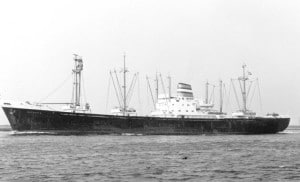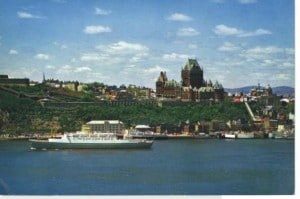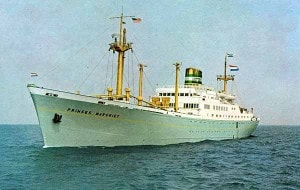The St. Lawrence river is an estuary river and when looking at it on a chart it looks like a wide converging funnel with a thin rope at the end (A rope with a thin pole alongside it, called the St. Lawrence Seaway). Thin is of course relative, the river is quite wide otherwise sea going cruise ships could not sail all the way to Montreal. From there the maximum size of a ship is dictated by the width of the Locks in the St. Lawrence Seaway. Holland America used to have ships that would go all the way up the Seaway and were built to fit in with the maximum lock dimensions.
There was one little passenger ship called the Prinses Margriet (*) and a series of cargo ships all starting with the letter K in the name. Katsedijk, Kloosterdijk, Kerkedijk etc.etc. With the start of containerisation, those ships quickly disappeared from the scene and were redeployed to the Gulf of Mexico.
We also had regular passenger ships going up the river in the 1950’s, mainly for the emigrant trade. The large express liners had been calling at Canadian ports since the 1920’s but did not go any further than Halifax while enroute to New York. But in the 1950’s there were two small Passenger ships called the Maasdam (III) and the Ryndam (II) who trundled up the river to Quebec and Montreal in high summer. I say “trundle” as with a maximum speed of barely 16 knots it took them some time. Especially with an adverse tide. Still, quite a few Europeans reached the New World that way and became Canadians in due course.
The river has not changed that much since then. Due to its shape, you are already nearly sailing in it before you realize that you are on a river and not sailing between some distant islands at the horizon. And that is the impression for all of us on board here as well. On departure Quebec we had the city on both sides but then the scenery changed quickly to lush green meadow lands interspersed with small hamlets, each with a very distinctive church, serving the needs of the surrounding agricultural communities. The river only widens very slowly but when it happens it resembles suddenly more a wide bay than a river.
So during the night and today the ship sailed with an average speed of 18 knots through this ever widening mouth of the river until it ended up in the open Ocean. From there it set sail to Prince Edward Island. Part of the River is regulated by Vessel Traffic Separation Schemes which keep the outgoing and incoming ships apart. That makes it fairly easy for the navigator to stay out of trouble. More focus is needed to comply with the environmental rules. The Maasdam also has a Zenon system which turns waste water back into fresh water but there are area’s on the river where even that sort of water cannot be discharged. There are Marine Sanctuaries with zero tolerance, anything closer to land than 4 miles is a no – no; except when the river has an outgoing tide, then the rules are a bit more lenient. The idea is that whatever goes overboard is quickly diluted by the water flowing towards the sea. We have nothing to dilute as the Zenon system produces clean water but the rules are the same for all. Under USPH rules and Can Pub health rules we are not allowed to re-use this water, so it has to go somewhere. It is a nice puzzle for the navigator to keep an eye on where that “somewhere” is.
In the old days we used to approach Charlotte Town from the West Side, going under the Confederation Bridge. That is not allowed anymore due to the large numbers of Lobster pots near the fairway. Sometimes these pots are in the fairway. But if a lobster pot gets its line tangled up in one of the propellers, it is the end for the lobster pot but the anchor rope could damage the seal in the propeller shaft that keeps the water out and the lubrication oil in. The ship does not want water leaking into the ship and the locals do not want oil leaking out although lubrication oil normally evaporates before it can do any harm. So the ships now have to go the long way around and approach from the East, sailing North around Prince Edward Island as the entrance to Charlotte town is located on the south side,
The Maasdam will approach the pilot station at 06.30 tomorrow morning and will be docked about an hour later. We are expecting glorious weather tomorrow. Windstill on arrival and a gentle breeze later on. Sunny skies all day long, but cool temperatures. Cool, as Autumn is quickly approaching.
(*) The Prinses Margriet never had a DAM name. She was bought from a company called the Oranje Line which names all its ships after members of the Royal Family (Which is from the House of “Oranje”) Prinses Margriet was and still is the God mother of the Dutch Merchant Navy and therefore Holland America decided not to rename the ship.




September 14, 2014 at 2:02 am
It is unfortunate that USPH and Can Pub health rules don’t allow ships to make use on-board of the purified (former gray and black) water. Doing so would seem to reduce fuel consumption and cost. But I guess the idea is that even if the system is partially failed it is safe to send the water overboard but not to drink it. If nothing else, I would think it would be good as technical water for washing decks, windows, etc.
Do you have any idea how many HAL passenger ships have not had a “dam” suffix (or a dyk suffix like the cargo ships) in their name? The m/s Prinses Margriet seems potentially unique in that regard (although the reason you give for keeping the name makes excellent sense).
September 14, 2014 at 7:35 pm
Thank you for reading my blog.
Yes the Health Rules are very strict, for that reason we are also not allowed to make water while on the Amazon and other rivers.
There were not that many HAL passengers ships without DAM. One we had in 1920 was the little coastel steamer called the Warszawa. It had been bought to run a feeder service from Dantzig in Poland to Rotterdam with Polish emigrants. The idea was that these new emigrants would feel more comfortable with a polish name than some “Double Dutch”. For the rest the was the Seven Seas which was officially owned by a German Subsidiary. Then we had the Groote Beer, which was owned by the HAL but operated in conjunction with the Dutch Government for emigrants in the 1950;s. It had two sisterships, the Waterman and the Zuiderkruis. They were operated by two other Dutch companies band to keep things a bit organized it was decided not to change to names to the individual companies nomenclature.
Best regards
Capt. Albert
September 15, 2014 at 8:55 pm
Ooops! The Rijndam II seems frighteningly familiar to me, Captain! Also the high river bank(s ?) are vaguely in my memory. At least, the Google search machine says that she was in use till 1973 ……. Where do you find these unique photos, Captain?
September 16, 2014 at 7:32 pm
The Maasdam had such a prop shaft seal issue and needed a replacement in June. Lucky enough we overnighted in Qubec City for the replacement work.